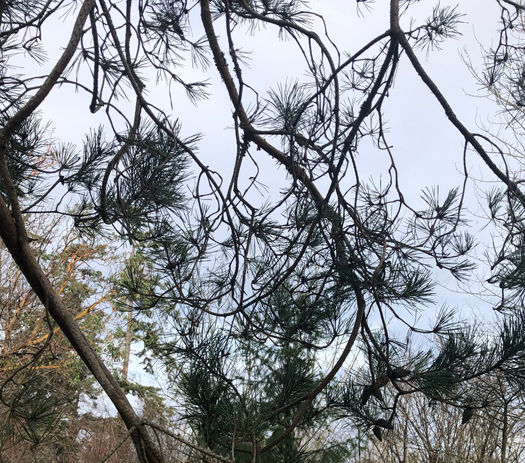
Shore Pine (Pinus contorta contorta)
The shore pine is a subspecies of Pinus contorta (Lodgepole Pine) and bears much resemblance to it, as does Pinus ponderosa (Ponderosa Pine). This evergreen conifer commonly reaches heights between 12-15 metres, but some have been recorded reaching 20-30 metres. Trees may grow tall or in a compact, shrub-like form. In all cases, the trunk and branches usually maintain some twisting and irregularity. The shrub-like form is often due to growing location, i.e. those near shorelines that are strongly influenced by higher concentrations of salt in the surrounding environment. The slightly flat, 3-7 cm long needles are a useful identification tool, as they are arranged two per bundle. In mature trees, the bark maintains a scaly appearance of plates on the trunk. The egg-shaped cones are about 2-5 cm long, and some may not open for several years!
The shore pine produces large pitch collections on the bark. Pitch was used by Indigenous groups for waterproofing and as an adhesive. Other traditional uses of shore pine include rope made from roots, splints from bark sheets and medicine. The shore pine was known to be an important species for a number of Indigenous groups, namely the Nisga’a, Haida, Sechelt, Saanich, Lower Stl’atl’imx, Coast Salish, Nuu-chah-nulth, Kwakwaka’ waku, Nuxalk, Tsimshian and Tlingit peoples.
Native to the Pacific coast, the shore pine’s range includes Alaska, Washington, Oregon, Northwest California and of course, British Columbia. Elevational range is between 0-600 metres (low to mid-elevations, including subalpine). Specific habitats may include rocky or exposed shoreline sites, bogs, dunes and crests. The shore pine is able to tolerate nutrient-poor conditions and salt spray, although these habitat conditions typically result in the tree’s more shrub-like form.
For more information, visit Biodiversity of the Central Coast, Oregon State University, and the Gymnosperm Database.



